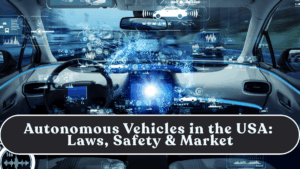The future of mobility is autonomous — and the USA is leading the way in developing self-driving vehicle (AV) technologies. However, as innovation accelerates, so does the need for strong regulatory oversight to ensure safety, privacy, and accountability. By 2025, most U.S. states have rolled out specific rules for AV testing, operation, and insurance, reflecting a nation preparing for a driverless era.

The Current Status of AV Regulation in the USA
Autonomous vehicle regulation in the United States operates on two levels:
-
Federal oversight, led by the National Highway Traffic Safety Administration (NHTSA), focuses on safety standards.
-
State-level policies determine how AVs are tested, licensed, and deployed on public roads.
As of 2025:
-
41 states and Washington D.C. have active AV laws or executive orders.
-
California, Arizona, Texas, and Florida lead in commercial AV deployment and testing zones.
Federal Framework and Safety Guidelines
-
AV 4.0 Policy (U.S. DOT & NHTSA):
Introduced as part of the “Ensuring American Leadership in Automated Vehicle Technologies” initiative.-
Defines safety benchmarks for automation levels (0–5).
-
Promotes innovation while ensuring crash avoidance and cybersecurity standards.
-
Encourages transparent data sharing by manufacturers.
-
-
Self Drive Act (pending update 2025):
Aims to set uniform nationwide standards for vehicle design, liability, and consumer data protection. -
Federal Motor Vehicle Safety Standards (FMVSS):
Being updated to include AV-specific hardware/software validation protocols.
Automation Levels and Legal Responsibility
| Automation Level | Description | Legal Liability |
|---|---|---|
| Level 0–2 | Partial automation (driver assists) | Driver responsible |
| Level 3 | Conditional automation | Shared driver/manufacturer |
| Level 4 | High automation (limited zones) | Manufacturer responsible |
| Level 5 | Full automation (no driver input) | Manufacturer fully liable |
At present, Level 4 vehicles — such as Waymo and Cruise robotaxis — are legally allowed in parts of California, Texas, and Arizona. Full Level 5 autonomy remains under development.
Key States Pioneering AV Policy
-
California:
Requires safety driver presence in most cases and detailed crash data submission. -
Arizona:
Allows fully driverless AVs on public roads under state supervision. -
Texas:
Has no requirement for human drivers during AV testing — a major draw for commercial players. -
Florida:
Allows commercial AV operation without steering wheels or pedals.
These states represent America’s most open environments for AV startups and global automakers.
Top Companies Leading the AV Revolution
-
Waymo (Alphabet): Operating robotaxi services in San Francisco and Phoenix.
-
Cruise (GM): Testing autonomous fleets for delivery and ride-hailing.
-
Tesla: Expanding “Full Self-Driving” (FSD) beta with constant software updates.
-
Aurora & Zoox: Partnering with logistics firms for autonomous trucking.
-
Apple & Amazon (Zoox): Developing closed-environment mobility platforms.
Ethical and Legal Challenges
Despite rapid innovation, several challenges remain:
-
Accident Liability: Who’s at fault — the driver, manufacturer, or software?
-
Data Privacy: AVs collect extensive driving and environmental data.
-
Cybersecurity Risks: Protecting systems from remote hacking.
-
Public Acceptance: Surveys show only 45% of Americans currently trust fully driverless cars.
To address these, policymakers are pushing for mandatory black box data logs and vehicle-to-infrastructure (V2X) communication safety checks.
Economic and Infrastructure Impact
The AV ecosystem could add $800 billion to the U.S. economy by 2035, generating millions of tech and logistics jobs. However, it may also displace certain driver-based roles, prompting retraining initiatives under the Future of Transportation Workforce Act.
Infrastructure upgrades are also underway — from smart traffic signals to 5G-based road networks that enable real-time communication between vehicles and cities.
Future Outlook: Balancing Innovation and Safety
By 2030, the U.S. aims to create a unified national AV framework. The focus will be on:
-
Safety-first automation testing across all states.
-
Data transparency for crash and performance reporting.
-
Ethical AI standards to prevent bias in automated decision-making.
Once fully integrated, AVs could reduce road fatalities by up to 90%, minimize congestion, and transform urban mobility forever.
Conclusion
The path to driverless mobility in the USA is well underway, guided by a balance of innovation and regulation. As states refine their laws and technology matures, autonomous vehicles promise safer, cleaner, and more efficient roads. The future of driving may not involve a driver at all — just a smart system steering the next generation of American mobility.
FAQs
Are self-driving cars legal in the USA?
Yes, but regulations vary by state. States like California, Arizona, and Texas permit commercial AV operations under strict guidelines.
What level of autonomy do today’s AVs have?
Most operate at Level 3–4, offering high automation in specific zones but not full autonomy.
Who is responsible in case of an AV crash?
Liability depends on the level of automation — typically shared between the driver and manufacturer for Level 3, and mostly manufacturer for Level 4–5.
How does the U.S. government regulate AV safety?
Through the NHTSA and DOT’s AV 4.0 framework, which set safety, cybersecurity, and performance standards.
When will fully autonomous cars become common?
Analysts expect Level 5 AVs to be commercially available between 2028–2032, pending legal and infrastructure readiness.
